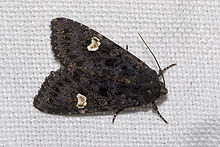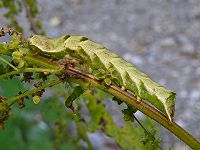- Dot Moth
-
Dot Moth 
Scientific classification Kingdom: Animalia Phylum: Arthropoda Class: Insecta Order: Lepidoptera Family: Noctuidae Genus: Melanchra Species: M. persicariae Binomial name Melanchra persicariae
Linnaeus, 1761The Dot Moth (Melanchra persicariae) is a moth of the family Noctuidae. It is found throughout Europe apart from the south-east.
This is a very distinctive species with very dark brown, almost black, forewings marked with a large white stigma from which the species gets its common name. The hindwings are grey with a dark band at the termen. The wingspan is 38-50 mm. It flies at night in July and August [1] and is attracted to light, sugar and flowers.
The larva is rather variable in colour, being green, brown or even purplish. It is marked with lighter diagonal markings and has a distinctive hump at the rear end. It is polyphagous, feeding on a wide variety of plants (see list below). The species overwinters as a pupa.
- ^ The flight season refers to the British Isles. This may vary in other parts of the range.
Recorded food plants
- Aconitum
- Actaea
- Aegopodium - Ground-elder
- Alnus - Grey Alder
- Aquilegia - Columbine
- Betula - Silver Birch
- Calluna - Heather
- Campanula
- Cirsium - Creeping Thistle
- Delphinium
- Hieracium - Hawkweed
- Impatiens - Touch-me-not Balsam
- Larix - Larch
- Lupinus - Lupin
- Lysimachia - Yellow Loosestrife
- Petunia
- Phlox
- Polygonum
- Prunus - Bird Cherry
- Pteridium - Bracken
- Quercus - Holm oak
- Ribes - Currant
- Rubus - Raspberry
- Rudbeckia
- Salix - Willow
- Sambucus - Elder
- Solidago - Goldenrod
- Sorbus - Rowan
- Spinacia - Spinach
- Tagetes
- Tropaeolum - Nasturtium
- Urtica - Nettle
- Vaccinium - Bilberry
References
- Chinery, Michael Collins Guide to the Insects of Britain and Western Europe 1986 (Reprinted 1991)
- Skinner, Bernard Colour Identification Guide to Moths of the British Isles 1984
Categories:- Melanchra
- Animals described in 1761
Wikimedia Foundation. 2010.

